WHAT ARE CAR T-CELLS
As far back as the 1980s, when AIDS was rampant and regularly taking the lives of young people, we understood the importance of T-cells and the immune system. Now, as we deal with what has emerged another near- epidemic of cancer in the developed world, it is logical to assume that T-cells can be useful in cancer treatment as a way of mobilizing the body to fight its own cancers the way it fights colds and viruses.
But although we’re close, we don’t yet have all the answers as to how and when the immune system can be mobilized to fight its own cancers.
Some of the best cancer treatment centers are in clinical trials with a form of therapy, CAR t-cell therapy, that has already induced remission in some kinds of tumors. The favorable results have been mostly in blood diseases like leukemia and lymphoma so far, but now this form of therapy is being tested in solid tumors.
Once a patient is deemed appropriate for CAR t-cell therapy, the patient’s own t-cells are collected by a process that takes blood out of the body and removes them. The process, apheresis, then returns the rest of the blood to the body, sending the T cells to labs. It’s a pretty common procedure to remove blood from the body and separate its components, replacing some of them. One common form of this is in the use of PRP (Platelet Rich Plasma), a person’s own plasma, injected back into the skin to reduce the appearance of aging.
In this far more serious instance, the patient’s T cells are genetically engineered. Although all T cells have chimeric antigen receptors (CARS), proteins that allow T cells to recognize specific antigens on tumor cells, these receptors have to be made to express.
Once genetically modified to express their proteins on the surface of the cell, the lab clones more of them until they number in the millions. The new cells are then frozen to be transmitted back to the patient, and infused back into the patient’s body like a blood transfusion.
So far, this therapy has been most effective when used in refractory cases of lymphoma, but the good news is that it has been quite effective at prolonging remission for more than a year in its clinical trials.
One of the centers on the leading edge of CAR t-cell therapy has been Dana Farber Cancer Center in Boston. In an article published last year in its own blog, the center recounts the journey of one patient toward remission. At the time the article was written, this patient was cancer-free:
Wilkins, who has owned her own beauty salon for 30 years, was in the hospital less than 10 days after her CAR T-cell therapy, and back to her salon in six weeks.
“Every three months I go back for PET scans and blood work, but I feel terrific,” says Wilkins, the mother of two grown children.
It’s important to understand that, while this is one of the most encouraging immunotherapies being tested, the trials have not lasted long enough to know whether they’ll produce an absolute cure.









